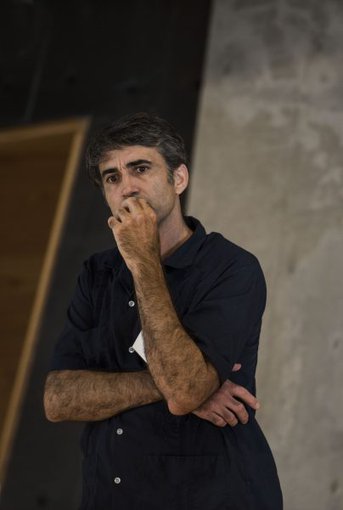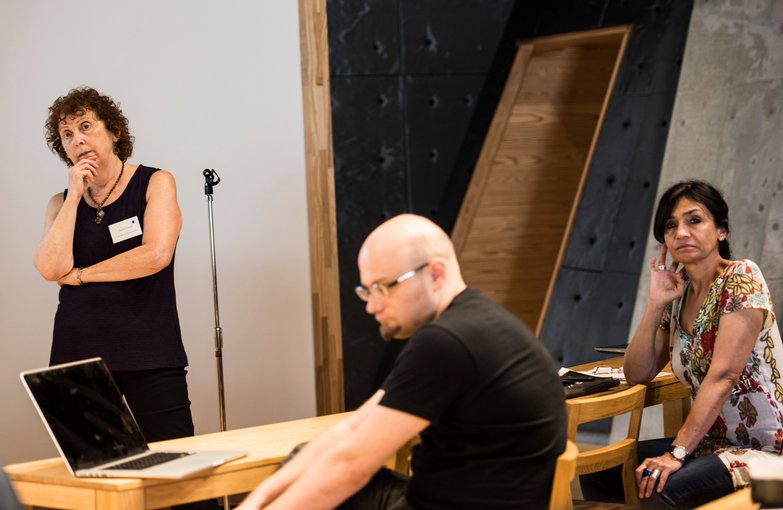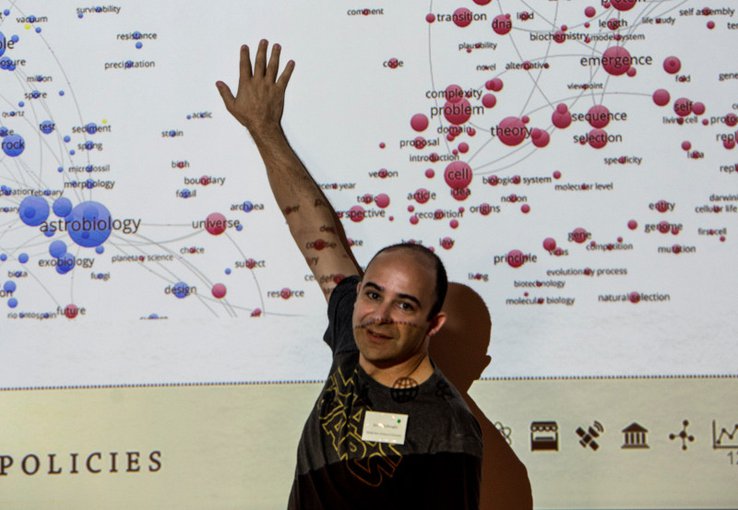
In 1953, the chemist Stanley Miller cracked open one of the deepest mysteries of science. Working under his mentor Harold Urey, Miller electrified a mixture of water vapor and gases thought to make up early Earth’s atmosphere, and soon obtained a brownish soup of amino acids—the building blocks of proteins and the key ingredients of life. And so was born the field of prebiotic chemistry and with it the modern quest for life’s origin.
But despite 60 years of effort, scientists have yet to figure out how lifeless molecules gave rise to living matter. If anything, the field has now reached a perplexing state of affairs. From primordial soup to RNA world, deep-sea vents to clay surfaces, test tube chemistry to computer simulations—origin research has grown into a fragmented web of disparate approaches and competing theories.

A group of scientists, historians and philosophers are gathered at the Earth-Life Science Institute in Tokyo, Japan to discuss the puzzling evolution of origin studies. Credit: Nerissa Escanlar
“There’s such a diversity of opinions on so many things in a way that’s probably not true of any other science,” said Jim Cleaves, a geochemist at the Earth-Life Science Institute (ELSI) and former graduate student of Stanley Miller.
Misunderstandings are rife at origin-of-life conferences, with attendees often “talking past each other and across purposes,” as one put it recently. Part of the problem is that origin researchers come from a wide range of backgrounds—from geology, chemistry, biology and evolutionary theory to philosophy, physics and computer science—all probing different parts of the proverbial elephant with the tools and language of their own trades.
And yet, there’s a growing realization that solving the puzzle will require stronger collaborations among the various communities and the integration of the field into a more coherent whole.
Last August, three dozen scientists and scholars from around the world gathered at ELSI in Tokyo, Japan for a workshop themed, “The History and Philosophy of Origin Research.” For three days, the attendees explored how historical baggage and old conceptual frameworks may influence current efforts to integrate the community.
The meeting (which one participant fittingly described as a “meta workshop”) was co-organized by Ana Barahona Echeverria, a professor of history at the Universidad Nacional Autónoma de México (UNAM) and Jim Cleaves, who also directs the ELSI Origins Network (EON), a project that aims to build a global community of origin scientists.
“Scientific research is not conducted in a vacuum,” Cleaves said. “Certain ways of thinking become encroached into the way researchers approach problems.” And so the goal was, as he put it, “to take a historical perspective” and perhaps “recognize some patterns in how this research has evolved over time.”
By the end of day three, a curious pattern had indeed emerged.

Jim Cleaves, a geochemist at ELSI. Credit: Nerissa Escanlar
Philosophical Foundations
What is life, anyway? A major problem with origin research is the lack of a clear-cut answer to this seemingly simple question. And so from day one the attendees grappled with the old philosophical chestnut of defining life.
Most researchers agree that life requires one (or more) of the following features: the ability to self-replicate; the ability to extract energy from the environment; and some sort of boundary between the inside and outside worlds. The problem, though, is that most disagree over which might have emerged first and been more relevant to life’s origin.
But to Carol Cleland, a philosopher at the University Colorado, Boulder, the predicament may lie right here—in confusing mere “signs” of life for the actual “essence” or “nature” of life.”
“These characteristics don’t need to be positioned as rivals,” Cleland argued, as they could be “little more than unreliable symptoms of more fundamental but as yet undiscovered general properties of life.” Indeed, this has been common in the history of science, with the same disease being named differently based on a different set of symptoms. “Could we be looking at symptoms of life and confusing them with what’s essential to life?” Cleland asked.

Philosopher Carol Cleland (left), artificial life researcher Nathaniel Virgo (center), and historian of science Ana Barahona Echeverria (right). Credit: Nerissa Escanlar
Cleland then singled out another conceptual dilemma in the field—that is, the divide between researchers who focus on different levels of abstraction. The issue is particularly flagrant between experimentalists and theoreticians. In other words, between those who study how certain molecules are put together in the lab and those who study abstract concepts (i.e. information) using computer models.
“Can we really talk about life without considering its underlying chemistry? Can we really separate the “logic of life” from its physical basis?” Cleland asked. The underlying material has got to matter, she argued. After all, a bridge made of stone and a bridge made of wood can’t be structured in the same way.
But to Nathaniel Virgo, an artificial life researcher and executive director of EON, the challenge is subtler than that. “The scientific question may be to figure out when the specifics matter, and when they don’t,” he said.
Indeed, there could well be universal abstract principles at play behind the emergence of life. And yet, specific geological features and environmental constraints could have given rise to the particular kind of life we ended up with on Earth.
At a previous workshop held at ELSI in 2015, the participants had identified three types of fundamental questions—historical questions (what happened on early Earth), synthetic questions (how can we build life), and universal questions (what are the abstract principles behind the nature of life).
“There’s no single best level of abstraction,” Virgo said. “That really depends on the questions you want to ask. The goal should really be to develop a language through which we can clearly communicate across these types of questions.”
Historical Baggage
Philosophical matters aside, the participants also mused over how much certain historical developments might have shaped the evolution of the field.
For instance, it’s hard to understate the impact of the year 1953, said Antonio Lazcano, a biologist also at the UNAM who has been investigating life’s origin for over 35 years. Indeed, not only was 1953 the year Miller performed his classic experiment, but it was also the year Watson and Crick unraveled the structure of DNA, and the year Sanger and Thompson published the first amino acid sequence of a protein. This cluster of developments had powerful repercussions on the ensuing trajectory of origins research. And so, molecular biology, the study of nucleic acids and their function in organisms, became the dominant perspective for decades to come.

Antonio Lazcano, a biologist at the Universidad Nacional Autónoma de México. Credit: Nerissa Escanlar
Yet it’s also important to keep in mind the historical context in which Miller’s work emerged, Lazcano noted. Indeed, Miller was heavily influenced by the writings of Russian biochemist Alexander Oparin, whose landmark 1938 book The Origin of Life arguably kick-started all serious scientific speculations on the subject. But Oparin’s thinking had also been particularly influenced by his own political and sociological milieu. Indeed, political affiliations in the Soviet Union had a direct impact on who embraced or rejected Darwin’s theory of evolution.
Oparin’s writings were steeped in Darwin’s legacy. And so he proposed a whole framework for the origin of life centered on the idea of chemical evolution. The process would have begun with the accumulation of organic molecules on early Earth, which then gradually became more complex under forces of chemical evolution, until they assembled into primitive forms of life. Stanley Miller’s work was meant to probe the early part of this process, the formation of life’s building blocks. In the field’s early days, life’s origin was mostly understood as a slow evolutionary process rather than a spontaneous formation of specific molecules.
But from the explosion of molecular biology in the ensuing decades emerged the popular “RNA world” hypothesis, the idea that self-replicating molecules with catalytic properties (hence capable of doing the jobs of both DNA and protein) may have been the protagonists of life’s origin.
However, some researchers today have been questioning the validity of the RNA world. In fact, the idea has come to mean different things to different people, explained Nathaniel Comfort, a historian of biology and the 2016 NASA/Library of Congress Chair in Astrobiology. While some researchers hold that RNA could have spontaneously emerged out of the prebiotic soup, others believe that RNA instead co-evolved along with proteins. And these different views, Comfort argued, may have emerged in part due to certain subtle developments in the history of molecular biology.
“It’s a scientific idea, but it’s also a school of thought,” Comfort said of the RNA world. “One of the things you can get from looking at those kinds of things is knowing what’s at stake when you invoke certain concepts or methodologies. If you understand where it comes from, then you can think more clearly about that subject.”
Still, other theories in the field only gained prominence as a result of pure chance discoveries. For instance, Mike Russell’s idea that life might have emerged near chemical gardens on the sea floor remained on the fringe for many years—until the fortuitous discovery of a field of alkaline hydrothermal vents dubbed the Lost City in the year 2000.
But the history of the field is also peppered with significant bodies of work that were lost to time or language inaccessibility, only to be re-discovered much later. Such was the case with the work of Mexican biologist Alfonso Herrera, who conducted pioneering experiments in the early 1900s and was one of the first 20th century researchers to attempt to “create life in a test tube”—before Stanley Miller even came to the scene. His work was only recently translated into English by Cleaves, Lazcano and Juli Peretó of the University of Valencia in Spain. Or take also the case of Hungarian biologist Tibor Ganti, who in the 1970s came up with a model for minimal life—the “chemoton”—but whose work was only translated decades later.
Ultimately, although three days didn’t allow the workshop participants to probe the entire evolution of such a complex field, one thing became increasingly clear—namely, the need for historians to provide insight into when the specifics might matter, and when they might not.
New Directions
In the first talk of the final day, Virgo advocated for a new kind of approach—one that embraces the “messiness” and complexity of the processes that might have unfolded on early Earth.
For the past 60 years, chemists have typically approached the puzzle by attempting to recreate molecules in a “clean” way, that is by working with tightly controlled and predictable chemical reactions. That’s the way they are trained, after all.
But it’s now clear that the emergence of life did not unfold in a clean bubble, as Cleaves had argued in a talk delivered on day two. Indeed, recent analyses with more modern and sophisticated tools of samples left over from Miller’s experiments have revealed chemical brews more complex than Miller himself ever imagined. What’s more, other evidence has shown that meteorites may have also delivered a huge array of complex organic molecules and building blocks for life to Earth. And so to understand how life might have emerged under these conditions does require a new kind of outlook and approach.
“The origin of life was likely a period of exploration and experimentation,” Virgo said, “where life tried out a huge array of possibilities and eventually converged to one particular form.”
“To probe this idea, what we really need is a theoretical and experimental science of ‘messy chemistry,’” he added. (He took a moment to show off his black T-shirt with the words “Messy Chemist.”) “The idea is not to seek prebiotic synthesis of biomolecules that resemble extant ones, but rather to seek principles of self-organization in complex chemical systems. The key point with messy chemistry is that there’s a large chemical space, but that there’s reason for optimism.”
Part of the appeal is the potential for this approach to bridge a gap between researchers who don’t typically collaborate, in particular between chemists who attempt to build life-like molecules in the lab and complex systems researchers who study abstract principles in simulations.
Interestingly, Takashi Ikegami, an artificial life researcher at the University of Tokyo, presented a model he believes to be particularly reminiscent of the kind of messy chemistry Virgo described—namely, the Internet.
Artificial life researchers have been trying to model life-like processes in computers for a while, Ikegami explained. But they’ve yet to recreate something that’d qualify as a true living system, whether because they’ve yet to find the right combination of parameters or they just don’t have systems that are complex enough to model actual life.
The web, however, seems to be one of most complex evolving system there is. And so Ikegami suggests using the web as a model for the prebiotic soup, as a kind of experimental test bed for messy chemistry. “You can find interesting things by looking at structure and transitions in the evolution of the web,” he said as he displayed examples from his studies of information flow on the social media site Twitter by analyzing certain tags and keywords.
The web is “a bit like an ant colony,” Ikegami said, and may even display “some kind of collective intelligent behavior.” Interestingly, many complex system researchers view these phenomena as related—ant colonies, swarm behavior, the nature of life, cognition, and the Internet. “Life and mind might share the same organizational principles,” argued Tom Froese, a complexity researcher also at the UNAM, in a talk about the concept of the individual in cognitive science and the origin of life.
And so, according to this approach, the origin of life would correspond to some evolutionary transition within a complex or “messy” chemical system, going from the growth of a loose network to the emergence of a highly integrated whole.

Sociologist Arsev Aydinoglu. Credit: Nerissa Escanlar
A Meta Quest
Perhaps the “meta” nature of the workshop became most apparent during the very last presentation given by the sociologist Arsev Aydinoglu. Aydinoglu, who studies patterns of collaboration within research networks, recently spent a couple of years with the NASA Astrobiology Program as a NASA postdoctoral fellow to look into the interdisciplinary nature of origins research.
During his talk he projected various graphs representing social networks within the field, based on criteria such as disciplines, number of publications, co-authorship, citations, and funding sources. Applying a social network approach, he looked at things like pivot nodes, clusters, and network health.
One slide listed the most productive and most connected researchers in the field, three of whom were present at the workshop. “These folks, through their publications, connect different communities,” Aydinoglu said.
“It’s important to work in the trenches and advance science,” Aydinoglu added, “but you also need people to synthesize and to bring communities together.” He also noted that places like ELSI and projects like EON may play a critical role in cementing these kinds of relationships and bringing more people together.
At this point, one couldn’t help but marvel at the way the community seems to emulate the very process it seeks to unravel—that is, an evolutionary process through which historical contingencies lead to both new vistas and blind alleys until a growing number of agents become increasingly integrated into a cohesive network. How poetic indeed, if understanding life’s origin did require a disparate collection of researchers to come together and form some sort of a social organism, which by becoming increasingly self-aware could direct its path toward the solution.
Aydinoglu’s presentation was followed by a lengthy discussion about the state of the field, including the need for historians and social scientists to help guide its progress by shedding light on the effects of ties, allegiance, and intellectual legacies. Amidst the banter over what it all meant, Nathaniel Comfort, the historian, turned to Nathaniel Virgo, the complex system researcher, and said jokingly: “You’ve got messy chemistry—well, I’ve got messy history.”


